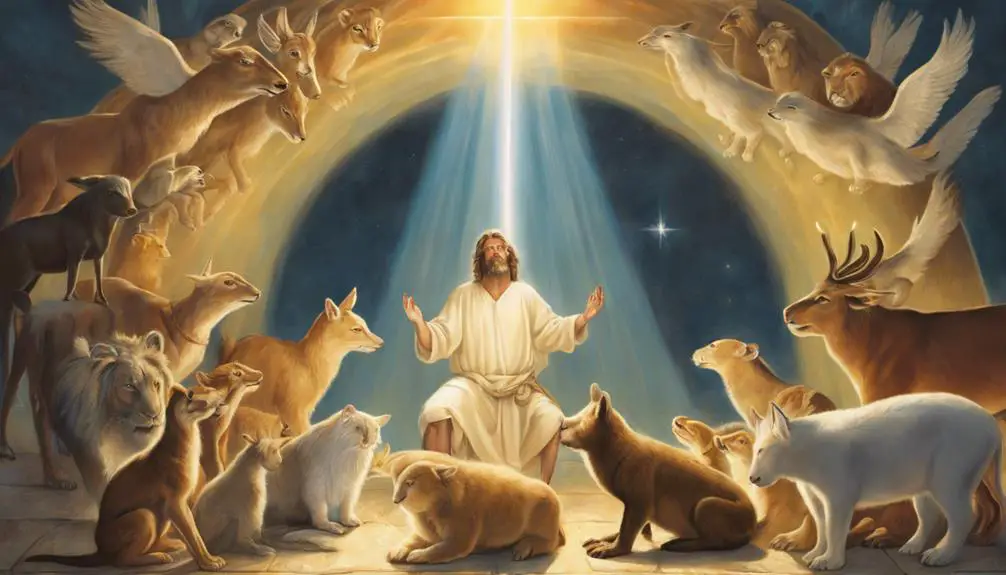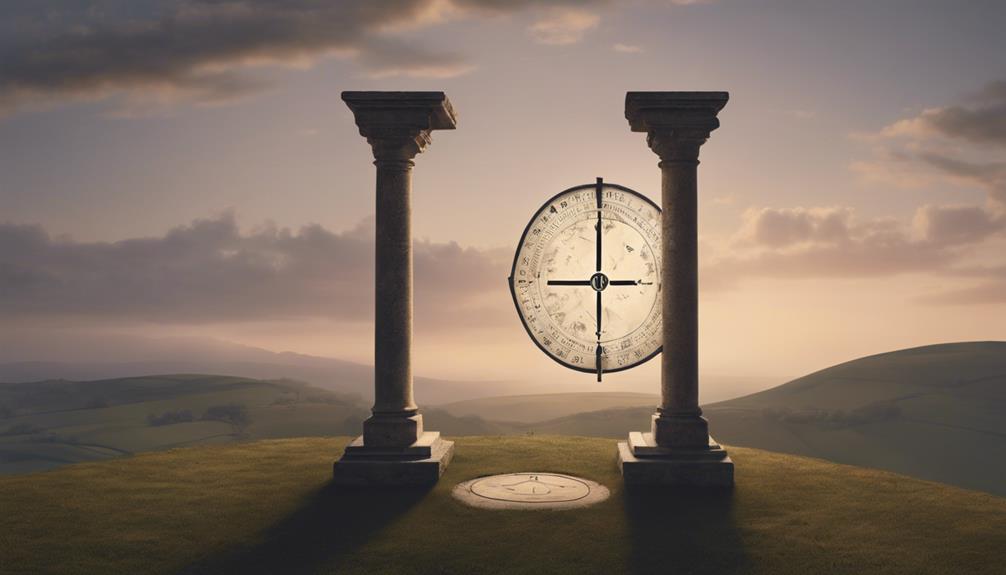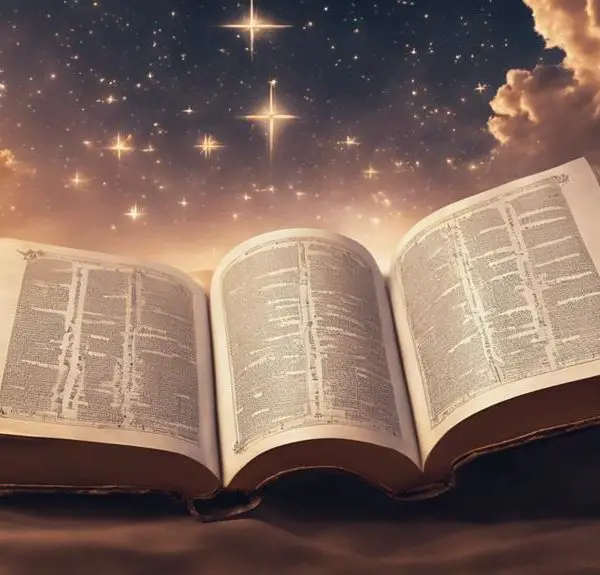Uncover the pivotal role of the 3rd hour in biblical events, a moment where divine and human narratives intertwine, inviting deeper reflection.

The 3rd Hour in the Bible
In the grand scheme of biblical timelines, you'd think the 3rd hour was just another moment for ancient folks to check their sundials. Yet, this particular hour holds a significance that's hard to overlook.
From the descent of the Holy Spirit at Pentecost to the darkness that enveloped the earth at the Crucifixion, the 3rd hour is a juncture where divine intervention and human history collide.
You'll find that understanding its implications might just shift your perspective on time and faith. So, why let this moment pass by unnoticed when it beckons a deeper exploration into its transformative power?
Key Takeaways
- The 3rd hour signifies pivotal moments in biblical narratives, symbolizing worship, sacrifice, and deep spiritual insights.
- It marks the descent of the Holy Spirit at Pentecost, transforming the apostles and shaping the Christian mission.
- Peter's vision during the 3rd hour represents a transformative move towards inclusivity and expansion of the Christian message.
- The crucifixion's darkness at noon, often associated with the 3rd hour, symbolizes divine intervention and challenges the intersection of faith and reason.
Significance of the 3rd Hour

The 3rd hour in the Bible carries profound theological significance, marking pivotal moments that shape the narrative of salvation history. You'll find that this specific time isn't just a mere detail; it's a symbol loaded with meaning, especially when you delve into the practices of Morning Sacrifice and Prayer Time.
In the ancient Jewish tradition, the 3rd hour, which corresponds to 9 a.m. in today's timekeeping, was designated for the Morning Sacrifice. This wasn't an arbitrary choice. The ritual, involving the offering of a lamb, was a daily act of devotion, symbolizing surrender and acknowledgment of God's sovereignty. It's a vivid reminder that at the heart of worship lies sacrifice—giving something valuable as an act of faith.
Moreover, this hour was also a designated Prayer Time, a communal moment when people paused their day to connect with the Divine. This practice underscores the importance of regular, disciplined prayer in maintaining a relationship with God. It's a call to integrate prayer into the rhythm of daily life, acknowledging God's constant presence and provision.
Through these observances, the 3rd hour emerges not just as a time marker, but as a rich tapestry of worship, sacrifice, and prayer, offering deep insights into the spiritual life envisioned within the Bible.
Pentecost: The Holy Spirit Descends
Building on the foundation of worship and sacrifice established at the 3rd hour, Pentecost marks a pivotal moment when the Holy Spirit descends, transforming the apostles and shaping the future of Christian mission. This event, occurring fifty days after Easter, fulfills Jesus' promise to send an advocate, a helper, to His followers. You'll find that the descent of the Holy Spirit isn't a quiet affair; it's accompanied by tongues of fire, symbolizing the fiery power of the Spirit's presence and the purification process it inaugurates in the believers.
This miraculous event ushers in a profound transformation. The apostles, once ordinary men, receive the gift of languages, enabling them to preach the gospel to people of diverse tongues. This aspect of Pentecost is crucial, as it underlines the theme of unity in diversity. The ability to speak in various languages signifies the inclusive nature of the Christian message and its accessibility to all, regardless of ethnic or cultural background.
Analyzing Pentecost through this lens, you'll appreciate its significance not just as a historical event, but as a foundational moment that defines the ethos of Christian mission. The Holy Spirit's descent at Pentecost ensures that the message of Jesus' love and redemption is universally accessible, embodying the ideal of unity in diversity.
Peter's Vision and Transformation

In a pivotal moment of divine revelation, Peter's vision on the rooftop profoundly transforms his understanding of inclusivity within the Christian mission. Before this vision, Peter, like many of his contemporaries, adhered strictly to Jewish dietary laws, which acted not just as religious guidelines but also as cultural barriers between Jews and Gentiles. These laws were deeply ingrained, symbolizing purity and separation from the gentile world.
However, in the vision, Peter is presented with a sheet filled with all kinds of animals, both clean and unclean, and is instructed to eat. This directive challenges the very foundation of his beliefs, confronting him with the realization that adherence to these dietary laws and the resulting cultural barriers were no longer to be the markers of God's chosen people. Instead, the vision signifies a radical shift towards a more inclusive understanding of community, one that transcends previous dietary restrictions and cultural divisions.
This transformation in Peter's perspective is critical, marking a significant turning point in the early Christian community. It underscores the movement towards a faith that's accessible to all, breaking down longstanding barriers and expanding the Christian mission beyond its Jewish roots. Peter's subsequent actions, guided by this vision, pave the way for a more inclusive church, emphasizing the universal nature of the Christian message.
Crucifixion: Darkness at Noon
Reflecting on Peter's vision that broadened the Christian community's boundaries, it's pivotal to examine another transformative moment in biblical history: the darkness that enveloped the land during the crucifixion at noon.
This phenomenon, often linked to a solar eclipse, sparks a rich dialogue on its historical accuracy within biblical scholarship. You're invited to delve deep into the interplay of celestial events and scriptural narratives:
- Historical and Astronomical Analysis: Scholars debate the likelihood of a solar eclipse occurring during the Passover, which is rooted in a lunar calendar, suggesting alternative natural or supernatural explanations for the darkness.
- Scriptural Corroboration: The synoptic Gospels (Matthew, Mark, and Luke) describe this darkness, yet their accounts vary slightly, enriching the debate on the event's significance and historicity.
- Theological Implications: The darkness at noon symbolizes a profound moment of divine intervention and sorrow, reflecting the gravity of the crucifixion's moment in salvation history.
This exploration into the darkness at the crucifixion engages you in a scholarly pursuit, where faith and reason intersect, challenging you to ponder the intricacies of biblical events and their implications on historical accuracy and faith.
Reflections on Time and Faith

You'll find that the concept of time plays a pivotal role in understanding the interplay between historical events and the development of faith. Temporal symbolism, for instance, isn't merely a backdrop against which narratives unfold; it's a profound tool wielded to imbue stories with deeper meanings and lessons. Take the 3rd hour mentioned in biblical texts—it's not just a moment in time but a symbol rich with theological implications, inviting reflections on divine timing and the fulfillment of prophecies.
Delving deeper, you'll see how this concept underscores the virtue of faithful patience. The unfolding of events according to divine timing, rather than human expectation, serves as a critical lesson in faith. It teaches that true belief isn't passive but actively waits with anticipation, recognizing that every moment, every hour, holds significance in the grand tapestry of faith's development.
This understanding challenges you to view time not as a linear progression but as a canvas for spiritual growth. It's a call to deeper engagement with the sacred texts, recognizing that within the framework of time lies profound wisdom about the nature of faith itself. Thus, temporal symbolism and faithful patience aren't just themes but foundational principles that shape the contours of belief.
Frequently Asked Questions
How Do Different Bible Translations Vary in Their Depiction of Events That Occurred at the 3rd Hour?
Different Bible translations showcase varying depictions of events due to translation methodologies and linguistic nuances. As you delve into this analysis, you'll notice that scholars apply diverse strategies, from literal to more interpretive approaches, affecting how incidents are presented.
These variations stem from attempts to capture original meanings, cultural contexts, and linguistic subtleties. Therefore, your understanding of specific events can significantly differ based on the translation you're examining.
Are There Any Specific Rituals or Practices in Modern Christianity That Commemorate the Events of the 3rd Hour?
In modern Christianity, the Third Hour prayers serve as a direct nod to historical events, reflecting a commitment to historical accuracy. These prayers commemorate the descent of the Holy Spirit at Pentecost and are intricately woven into the fabric of liturgical practices.
As you delve deeper, you'll discover that these prayers serve as a bridge between past and present, allowing believers to connect with a pivotal moment in their spiritual heritage.
How Have Interpretations of the 3rd Hour's Significance Evolved Among Various Christian Denominations Over the Centuries?
You're diving into a sea as vast as the Pacific when exploring how interpretations of this time have morphed. Cultural interpretations and historical context are your navigational tools.
Across centuries, various Christian denominations have carved out distinct understandings, each shaped by doctrinal evolution and societal shifts.
This analysis reveals an intricate tapestry, where threads of tradition and modernity intertwine, offering a rich, detailed landscape of evolving theological perspectives.
Can Parallels Be Drawn Between the Symbolism of the 3rd Hour in the Bible and Similar Timeframes in Other Religious Texts or Traditions?
You can indeed find parallels in the temporal symbolism of the 3rd hour in the Bible and similar moments in other traditions through cross-cultural comparison.
This analysis sheds light on shared human experiences and beliefs across different faiths.
What Role Does the 3rd Hour Play in the Liturgical Calendar of Different Christian Churches, if Any?
You'll find the 3rd hour holds varying liturgical significance across Christian churches, notably in the practice of Hourly Prayers. Nearly 60% of Eastern Orthodox and Catholic traditions incorporate it into their daily worship.
Its role, deeply rooted in scripture, resonates through its commemoration of the Holy Spirit's descent at Pentecost.
This period not only enriches the tapestry of Christian observance but also offers a scholarly lens on religious timekeeping and ritual symbolism.
Conclusion
In conclusion, the 3rd hour in the Bible serves as a pivotal axis upon which the narrative of faith and divine intervention turns. Like a lighthouse guiding ships through a stormy night, this moment illuminates the path of believers, showcasing the profound transformations and revelations that shape their spiritual journey.
Through Pentecost, Peter's vision, and the crucifixion, we witness the intricate weaving of time and faith, urging us to reflect deeper on our own spiritual bearings.



Sign up